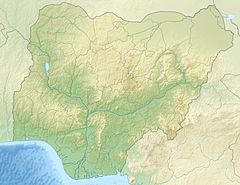The Rop rock shelter is an archaeological site on the Jos Plateau of Nigeria. There are two layers containing artifacts. The first holds large scrapers and backed crescent-shaped stone tools. The later (upper) layer is about 2000 years old, and contains backed microlithic tools and pottery.[1] The shelter is about 50km south of Jos.[2]
| Location | Jos Plateau |
|---|---|
| Region | Nigeria |
| Coordinates | 9°20′57″N 8°51′17″E / 9.34917°N 8.85472°E |
| Site notes | |
| Excavation dates | 1944 |
| Archaeologists | Bernard Fagg |
The site was excavated by Bernard Fagg in 1944. He discovered microliths, fragments of ground stone axes, two bored stones, one grooved stone, rubbed hematites and many potsherds.[3] The lower, undated layer held relatively crude implements, apart from the rough crescents. The later layer held higher-quality microliths, geometrical forms and small points, as well as pottery.[4] This later layer only covers part of the site.[5] A skeleton was also found in a shallow grave, dated to around 25 BCE From the teeth, it appeared that the owner had lived largely on a starchy, plant-based diet.[3] A single equid tooth was found with the same age based on its position in the stratum.[6][3]
References
edit- ^ Barbara Ann Kipfer (2000). "Rop". Encyclopedic dictionary of archaeology. Springer. p. 484. ISBN 0-306-46158-7.
- ^ J. Desmond Clark (ed.). The Cambridge history of Africa, Volume 1. Cambridge University Press. p. 421. ISBN 0-521-22215-X.
- ^ a b c Kit W. Wesler (1998). Historical archaeology in Nigeria. Africa World Press. p. 206. ISBN 0-86543-610-X.
- ^ J. Desmond Clark (ed.). The Cambridge history of Africa, Volume 1. Cambridge University Press. p. 785. ISBN 0-521-22215-X.
- ^ John Desmond Clark, Steven A. Brandt (1984). From hunters to farmers: the causes and consequences of food production in Africa. University of California Press. p. 153. ISBN 0-520-04574-2.
- ^ Thurstan Shaw (1995). The Archaeology of Africa: Food, Metals and Towns. Routledge. p. 92. ISBN 0-415-11585-X.
